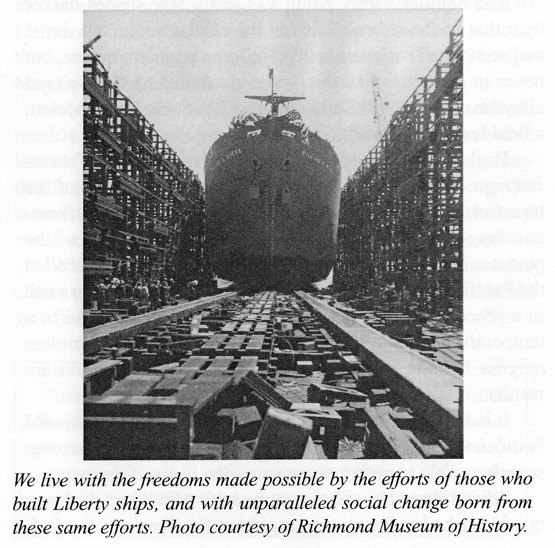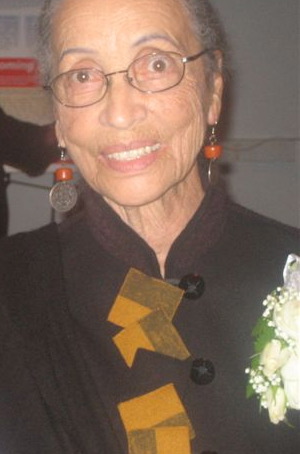
THE BETTY REID SOSKIN PAGES
THE GREATEST WARTIME HOME FRONT MOBILIZATIONSTORY IN HISTORY IS TOLD BY NATIONAL PARK SERVICE
IN CITY OF RICHMOND
By: Betty Reid Soskin
Cultural Resources Assistant, National Park Service
Rosie the Riveter/World War II Homefront National Historical Park
Published in the California Historian, Spring, 2009 edition
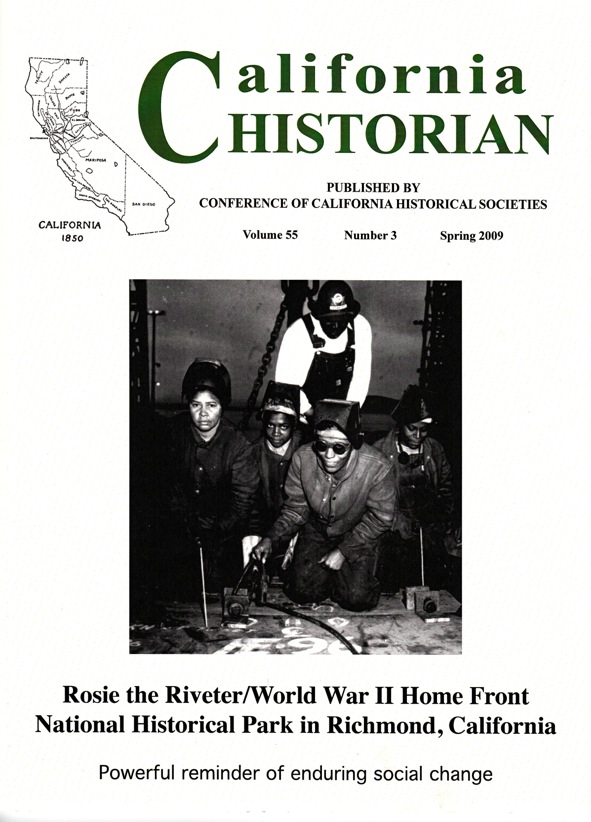
In October of the year 2000 and under the leadership of Richmond city council member, Donna Powers, and the Bay Area’s Rep. George Miller, Congress legislated Rosie the Riveter Home Front National Historical Park at the City of Richmond as the best place in the nation from which to tell the story of the greatest work force mobilization in the history of the country; that of the World War II Home Front war effort. It is the mission of the National Park Service (NPS) to collect and tell the nation’s stories through the memories of its people, existing structures, and sites of significance. Nowhere in the country were there more still-standing historic sites through which this could be done – but only because Richmond had not yet begun to demolish them for various redevelopment plans over the decades following WWII. That would hold true for the entire Bay Area where many home front related structures may still exist but are threatened by a fading collective memory. Many residents currently living throughout the Greater Bay Area can date their family’s arrival to a mere 67 years ago – during WWII. That past has not yet mellowed into “history.”
The original intent of the legislation was to honor the Rosies, the newly-emancipated women of the home front who replaced men in active battle; a story worthy of the telling, surely. However, as with many of the parks in the National Park System, once one begins to explore that history in any depth it becomes clear that there were equally compelling multiple stories, often conflicting, but nonetheless each critical to the building of a baseline against which to measure the succeeding 20 years of unprecedented social change in a nation undergoing monumental adjustments that would resonate out into the world and into the present.
Did Port Chicago explosion
Presage the Civil Rights Movement?
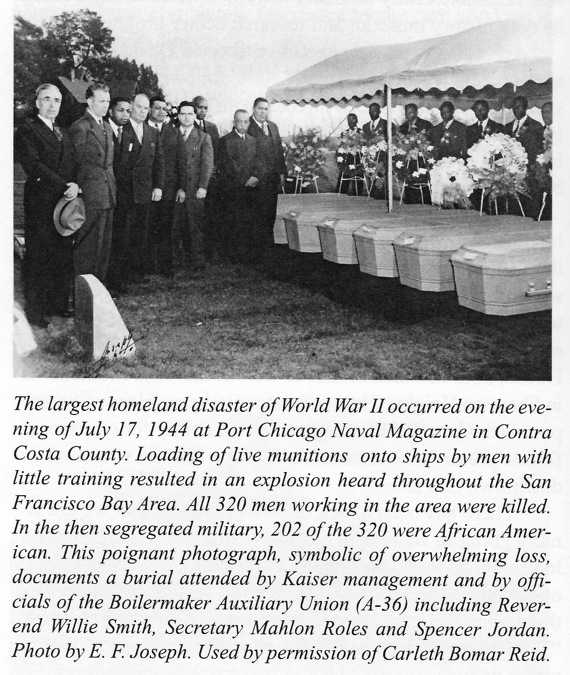 It can be argued that the modern Civil Rights Movement had its beginnings in the Greater Bay Area dating from the tragic explosion at Port Chicago and the resulting highly controversial mutiny trials. One can trace the movement from the Naval Weapons Station in Concord on that fateful day of July 17, 1944 through to the Free Speech Movement that originated on the University of California Berkeley campus; to the Oakland Induction Center demonstrations; to Freedom Summer 1964 in Mississippi with students from the Bay Area leading the way; to the creation of the Black Panther Party by the children of wartime migrant workers which signaled a new nationalist attitude among African Americans; to the people’s March from Montgomery to Selma; to the Montgomery bus boycott, and beyond. The Bay Area was the birthplace of the history that altered and dominated the direction of change in that prophetic era which challenged existing national civil rights and civil liberties policies for all time.
It can be argued that the modern Civil Rights Movement had its beginnings in the Greater Bay Area dating from the tragic explosion at Port Chicago and the resulting highly controversial mutiny trials. One can trace the movement from the Naval Weapons Station in Concord on that fateful day of July 17, 1944 through to the Free Speech Movement that originated on the University of California Berkeley campus; to the Oakland Induction Center demonstrations; to Freedom Summer 1964 in Mississippi with students from the Bay Area leading the way; to the creation of the Black Panther Party by the children of wartime migrant workers which signaled a new nationalist attitude among African Americans; to the people’s March from Montgomery to Selma; to the Montgomery bus boycott, and beyond. The Bay Area was the birthplace of the history that altered and dominated the direction of change in that prophetic era which challenged existing national civil rights and civil liberties policies for all time.
Social change was happening far too rapidly for anyone to process; too fast to absorb and grow from; too far-seeking to encompass or understand; too traumatic to retain for our children.
Only now, given the scattered sites upon which they happened and the necessary governmental support through the NPS is there the scholarship, the time, the staff, and the beginnings of an appreciation of how far we’ve come after decades of an awesomely painful national struggle. We are finally mature enough as a larger community to take the time to remember, appreciate, and document that truly astounding human journey. The Greater Bay Area is the palette upon which we can paint the story of those times for the entire nation. We’re only now mature enough as a collective of California migrants from elsewhere on the continent and the world – to tell the uniquely American Story of the greatest wartime home front mobilization in history and the extent to which it helped to “form a more perfect union”.
Phenomenal home front mobilization
Saved nation and world
According to Kaiser Permanente historians, it took 7 workers at home to support each fighting man or woman on the battlefield. The great PBS documentary filmmaker, Ken Burns, brought to us the story of WWII – the fighting war. No one has yet told the story of the phenomenal mobilization of ordinary Americans of all races, religions, abilities and disabilities, ethnicities – brought together by the common need to survive a Great Depression combined with a fear of world Fascist domination and the rising sense of patriotism -- to build and maintain the machines, weapons, and tools of war. That wartime victory was largely won here in this place that so many of the recently-arriving Californians now called home. Few can be found today who’ve carried with them any sense of having contributed so much toward the saving of the nation and the world. The unspoken sense of sharing and sacrifice was so equal in the general population – despite racial and cultural differences – that few have lived into our time in full appreciation of that reality.
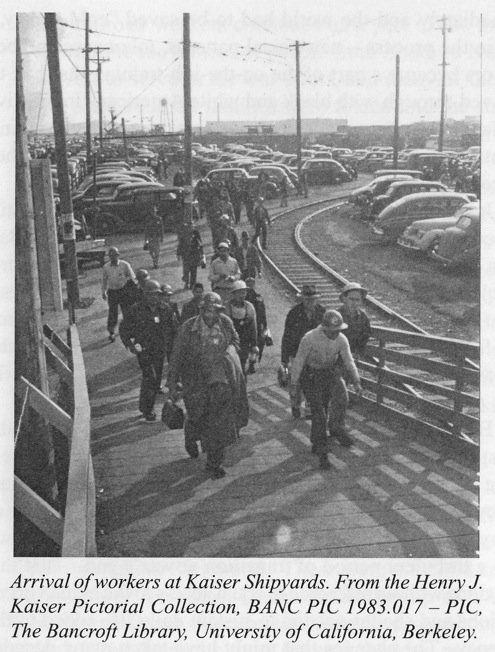 The City of Richmond is important to the narrative because it allows us to tell that national story in microcosm. In 1941 the population consisted of 23,000 people in a working-class community dominated by Standard Oil, Atchison Topeka & Santa Fe railroads, and the Pullman Company, a town that was incorporated shortly after the turn of the last century, in 1905. Within 18 months after the Japanese aerial attack at Pearl Harbor, Richmond’s population had grown to 128,000. In contrast, in the period immediately after the closing of the shipyards -- jobs were reduced from 98,000 working around the clock on 3 shifts -- to a mere 10,000. Without a hint of how and when the war would come to an end, there was no preparation for how to deal with the disruption to human lives that ensued. Sixty-seven years later, the city’s population which had contracted so drastically with the war’s end – is again counted at 102,000. This expansion and abrupt contraction then slow re-expansion barely hints at the underlying human story of transplanted lives of many thousands of ordinary Americans who had little sense of the heroism that would be required in order to live it through unscathed. It is still uncertain as to whether we actually did so. The manner in which that population survived is what creates the dramatic narrative that forms the premise upon which the park was established.
The City of Richmond is important to the narrative because it allows us to tell that national story in microcosm. In 1941 the population consisted of 23,000 people in a working-class community dominated by Standard Oil, Atchison Topeka & Santa Fe railroads, and the Pullman Company, a town that was incorporated shortly after the turn of the last century, in 1905. Within 18 months after the Japanese aerial attack at Pearl Harbor, Richmond’s population had grown to 128,000. In contrast, in the period immediately after the closing of the shipyards -- jobs were reduced from 98,000 working around the clock on 3 shifts -- to a mere 10,000. Without a hint of how and when the war would come to an end, there was no preparation for how to deal with the disruption to human lives that ensued. Sixty-seven years later, the city’s population which had contracted so drastically with the war’s end – is again counted at 102,000. This expansion and abrupt contraction then slow re-expansion barely hints at the underlying human story of transplanted lives of many thousands of ordinary Americans who had little sense of the heroism that would be required in order to live it through unscathed. It is still uncertain as to whether we actually did so. The manner in which that population survived is what creates the dramatic narrative that forms the premise upon which the park was established.
It should not be difficult to see behind those dramatic figures the chaos brought by such life-changing demographic shifts. That “change” was necessarily accelerated by virtue of the speed and urgency of the times has become embedded in the ethos of place, and continues to prevail in the political and social cauldron established here by the war years long ago. The San Francisco Bay Area continues to be the catalyst for change for the state and the nation – often controversial but always acting as pathfinder for a country still characterized as a world power by its youth and brashness.
Bay Area becomes the catalyst
for continuing and irreversible social change
The cauldron created in the war years to serve the cause of industry was ignited in large part by the worker-population being brought together to share workplace, hastily-built temporary HUD wartime housing, school facilities, hospital care, without the benefit of any of today’s “sensitivity” training programs. The ships and the planes had to be built immediately and the world had to be saved “cold turkey,” and in the process – new social patterns, tolerances, and behaviors became a part of the on-the-job-training that had to be lived through with black and white Americans in this living laboratory -- workers who would not be sharing drinking fountains, schools, public transportation, hospitals, for another 20 years in their places of origin. Just how successfully we survived that process can still be seen in the forward-thinking that has endured in the Bay Area over the ensuing half-century. Coping mechanisms developed by necessity through those hard years of adjustment set behavioral social patterns that continue to place California and the Bay Area as leading change-agents for the nation as we continue to adapt to a faster-changing world than that being experienced by the rest of the country.
By bringing together in this place the essential elements, the stirrings that would have eventually risen to the surface – were suddenly thrust forward fueled by a new sense of urgency born of the dislocation and eventual abandonment of many thousands of black and white American families thrown into a turbulent period of transition at war’s end. That this was done without reference to equal access to the human needs for jobs and shelter needed to sustain daily life added to the urgency. The changes that might have taken many decades to accomplish were suddenly fast-tracked by circumstance and new black expectations. Black hope rose to collide with White privilege and the demand for social change was now inescapable – and once begun – was insistent and irrevocable; giving birth to the modern Civil Rights Movement
Rosie the Riveter World War II
Home Front National Park
charged with interpreting that history
It will be the work of Rosie the Riveter WWII/Home Front National Historical Park to recapture the spirit of the times through the collection of oral histories, and related artifacts; through applying newly-developed technologies to open doors to information long dormant and now threatened by advancing time that has taken the lives of so many of those who created that history at the time.
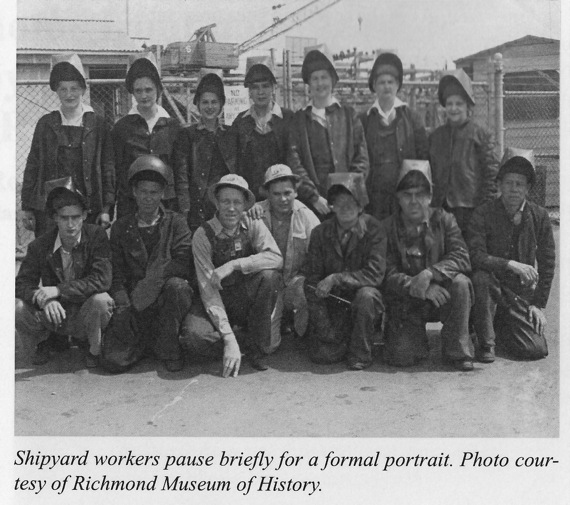 The macro involved the entire Bay Area and the State of California which saw unprecedented growth its in population over a relatively short period – and has continued to grow exponentially ever since. The national story of the home front mobilization involves a variety of industries; aircraft construction, ammunition and armaments, transportation systems, textile industries, massive warehousing and shipping operations to service the Pacific battlefront, and a myriad of enterprises that provided all of the elements needed until peace came in 1945.
The macro involved the entire Bay Area and the State of California which saw unprecedented growth its in population over a relatively short period – and has continued to grow exponentially ever since. The national story of the home front mobilization involves a variety of industries; aircraft construction, ammunition and armaments, transportation systems, textile industries, massive warehousing and shipping operations to service the Pacific battlefront, and a myriad of enterprises that provided all of the elements needed until peace came in 1945.
The local narrative is dominated by shipbuilding, and it is through Kaiser Permanente’s still-standing historic sites that those stories can best be told as we work to incorporate the national stories as the home front story evolves. But the story is not limited to Kaiser Permanente, but will provide archives and museum space for all of the home front industries scattered throughout the Greater Bay Area and the nation.
The Stories
- There is the story of Rosie the Riveter, the women who left hearth and home to replace the men on the battlefields. Many entered the workplace for the first time in history. They not only built the ships, tanks, and planes; and then ferried planes to the war fronts. They picked up the instruments and “manned” symphony orchestras. They became the designers and architects. They dispatched trucks and trains and “manned” the front offices of wartime industries. They learned new skills far beyond their imaginations, prior experience, or their own expectations.
- But Rosie’s was essentially a white woman’s story. Black women shared a far different history of the times. Before 1941 African American women had but two choices in employment – in agriculture and as domestic service workers. Though there were exceptions, racial bigotry prevented their entry into the workforce in any significant numbers until late in 1944 – another untold story. For several years after massive recruitment of unskilled white female workers for the war industries, black women began to replace white women who were entering the workforce and employers began to accept black women at those lower level jobs being vacated by white women who were moving into higher-paying war-related work. Before the war years 31% of white women were in the national workforce (mainly in traditional nursing and teaching positions) while 85% of black women worked outside their home due to the low salaries paid to black men, 25 to 35 dollars for a 40-60 hour work week.
- There is the story of Henry J. Kaiser the Industrialist; a bold man with an 8th grade
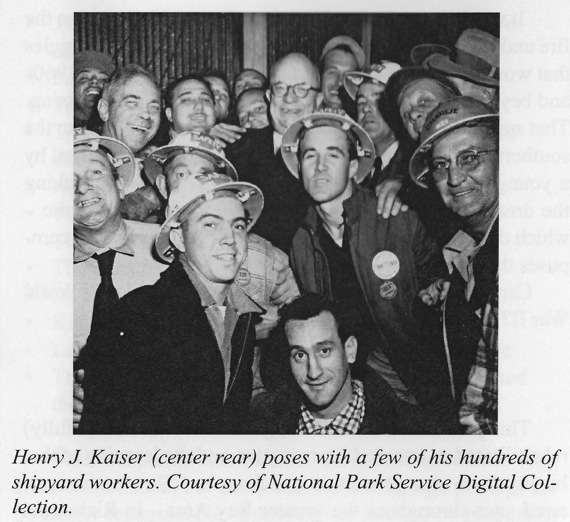 education; a cement contractor who had never built a ship yet believed that – by adapting to shipbuilding the pre-fabrication techniques of the auto industry pioneered by Henry Ford – he could drastically reduce the time required for ship construction. But first it was necessary to build the shipyards in order to build the ships. This he did for the British under Lend Lease government contracts prior to WWII. Kaiser flattened the nearby hills and filled in the bayside wetlands in order to make his vision of creating 4 local shipyards possible.
education; a cement contractor who had never built a ship yet believed that – by adapting to shipbuilding the pre-fabrication techniques of the auto industry pioneered by Henry Ford – he could drastically reduce the time required for ship construction. But first it was necessary to build the shipyards in order to build the ships. This he did for the British under Lend Lease government contracts prior to WWII. Kaiser flattened the nearby hills and filled in the bayside wetlands in order to make his vision of creating 4 local shipyards possible.
After the enemy attack by the Japanese at Pearl Harbor on December 7th of 1941 -- Kaiser sent his recruiters out to the five southern states of Louisiana, Texas, Oklahoma, Mississippi, and Arkansas, to bring back an unskilled crew of countless workers who would become the builders of 747 ships over the next 3 years and 8
months. His plan was to train tens of thousands of depression-scarred unskilled workers to do very small parts of very large jobs. He needed hands; many hands, attached to as many assorted live bodies as he could recruit. They answered the call by boarding trains, trucks, box cars; packed into whatever mode of travel they could find. And they stayed on.
- There is the story of Black migration across the country, families with new hope for a brighter future for their children. The home front defense work opportunities would speed up the migration already in motion. Having discovered the west coast earlier, many black Pullman porters had been bringing their families out of the south in a slow but steady stream throughout the twenties and thirties in order to escape white southern hostility and the demeaning culture of Jim Crow. That movement was accelerated by the need for defense workers. Many railroad workers continued as a part of the massive wartime movement of people from South to North and West to serve in the war effort, and many of the in place black railroad families were folded into the shipyard workforce along with the more recent black migrant arrivals.
- There is the horrific and shameful story of the Japanese-American relocation and internment that involved the forced removal from Bay Area communities of 140,000 people, 70,000 of whom were American citizens.
- There is the story of the Double V campaign waged by the national Negro press and the NAACP in order to try to take advantage of the times in order to advance the cause of democracy by confronting unfair and discriminatory practices in employment, education, and housing, for people of color.
- There is the story of early childhood education. In order to accommodate the needs of the women brought into the workplace, Kaiser Permanente and the Maritime Service created 11 child development centers that were scattered throughout Richmond. These were not childcare, but places of learning. Under the leadership of a UC Berkeley professor, those centers were the progenitors of today’s Head Start, the most forward-thinking program in the history of early childhood education.
Except in rare cases, such services were available only to white families. Black families brought with them from the south a long tradition of collective parenting that served them well as they adjusted to the new and unpredictable living environment in a wartime economy. Black expectations were modest at the time, but grew with time and exposure to a less limited version of the American Dream which seemed possible in the chaotic New West. This was not only the edge of the continent, but was proving now to be the absolute cutting edge of social change.
Another important part of the story of those times is embedded in the fact that – many who settled in the State during and after the war, brought with them the belief that this was a place where freedoms involved more than mere aspiration. The growing belief beyond the state’s borders -- in the Art of the Possible -- may have given weight to the self-fulfilling prophecy that the San Francisco Bay Area might become the place where change was not only tolerated, but embraced. That, too, was a product of the great mobilization of the era. The testing of the concept of Democracy that became the outer expression of our inner hope that out of chaos might come the opportunity to create a more enlightened world, and that ordinary people could bring this about. That legacy persists and never more clearly than in the cities of San Francisco and the East Bay communities that rim the Bay.
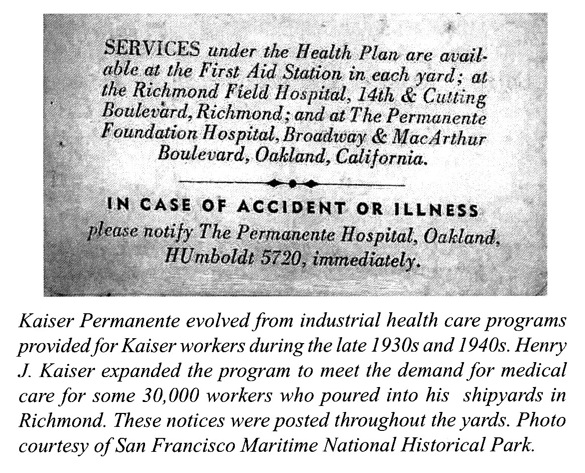 There is the story of affordable health care not born of altruism, but of the belief on the part of Henry Kaiser’s great collaborator, Dr. Sidney Garfield, that productivity was of necessity tied to health and safety. Together they created the model for Health Maintenance Organizations (HMO’s) that are still actively serving the working class and many others today, nationwide, by bringing affordable healthcare to millions while serving well the medical professional community upon which it rests.
There is the story of affordable health care not born of altruism, but of the belief on the part of Henry Kaiser’s great collaborator, Dr. Sidney Garfield, that productivity was of necessity tied to health and safety. Together they created the model for Health Maintenance Organizations (HMO’s) that are still actively serving the working class and many others today, nationwide, by bringing affordable healthcare to millions while serving well the medical professional community upon which it rests.
Bay Area as Nerve Center for the War in the Pacific
It should be remembered that the Greater Bay Area was that for the first two years of the War the Presidio in San Francisco was the headquarters for the war in the Pacific, and that the City of Richmond was the nerve center of that nerve center.
One could go on interminably, but this should suffice. It should be obvious to even the most casual observer that the Bay Area was then and still is the pivotal place in the nation where monumental industrial, educational, and social change started on the path that is still being emulated across the nation. It was during those years that we became the trendsetters for social change for the nation and the world, a role we still play – though until now we’ve been too busy adjusting to changes we’ve never really processed well enough to fully appreciate.
What hasn’t yet been stated is that the needs of that monumental mobilization for the purposes of shipbuilding and the recruitment patterns of the Kaiser Permanente Corporation inadvertently created the transference of the entire system of racial segregation from those five southern states – bringing together into the Greater Bay Area white and black folks still marked by the lasting effects of a Civil War mentality and who shared little history in common, except that marked by pain and misery -- and whose expectations for a continuing system of white privilege over black subjugation would be in conflict for at least another 20 years. It was here in the San Francisco Bay Area, then, that the caldron was lit that would begin the struggles that would spread to the rest of the country during the Sixties and beyond. It is that history that we’re late in processing. That spirit of change washed across the continent back to the southern places from whence it came, this time supported by a younger generation of student leaders bent upon making the dream of true democracy more than purely symbolic -- which then gave rise to unprecedented unrest on college campuses throughout the country.
Can all that be attributed to the great mobilization of World War II? Unquestionably.
The Sites that commemorate history
This partial list of sites being identified and (hopefully) rehabilitated and restored for visitation and the learning of that history for a new generation are on scattered sites throughout the Bay Area. In Richmond the National Park Service is working to raise the awareness for historic preservation within the community and beyond. The story is far greater than that of this single city (now declared a national park with scattered sites). The more complex story reaches beyond it and encompasses the greater Bay Area which someday may come to be identified as a Heritage District. Some relevant historic sites under study:
- Oak Knoll Naval Hospital in the Oakland Hills
- Letterman Hospital, at the Presidio, San Francisco
- Hunter’s Point Shipyard in South San Francisco
- MarinShip in Sausalito, shipyard operated by Bechtel Corp.
- Marin City Housing Development
- The Oakland Army Base
- Southern Pacific Railway Station (16th & Wood in Oakland)
- Moore Dry Dock Company
- The Alameda Naval Air Station
- The Vallejo Shipyards
- Benicia
- The Kaiser Permanente Field Hospital (Cutting Boulevard)
- Kaiser Warehouse at Shipyard 3
- Kaiser Paint Shop and Riggers Loft at Shipyard 3
- The Maritime Child Development Centers (Richmond)
- Nystrom Wartime HUD housing and school
- Atchison Village Maritime Housing Co-operative
- The SS Red Oak Victory – moored at Richmond Shipyard III
- The Oakland Induction Center (Clay Street in Downtown Oakland)
- Cordonices Village – Albany
- Camp Ashby for black MP’s – at the foot of Ashby Avenue in Berkeley
- The Leamington Hotel, the wartime administrative offices for the US Air Force (19th at Broadway in Oakland)
- Port Chicago Naval Weapons Station
- Treasure Island Naval Station
- The International Hotel (for black porters, only) on South Street in Richmond
- Neighborhood House of North Richmond
- The Buchanan Street USO (for blacks only)
- The Bayview Opera House at Hunter’s Point
- The Buchanan Street USO (blacks only)
- Sweet’s Ballroom on Oakland’s Grand Avenue
- Kaiser’s Shipyard III
- Lawrence Laboratories in Berkeley and Livermore
- The Hornet; USS aircraft carrier now a museum based in Alameda
- The San Francisco Opera House; the site that hosted the birth of the United Nations
This is a partial list. Most of these sites have been long since demolished, but many still remain though perhaps are no longer recognizable. Some can be marked by plaques of remembrance. Some can be restored to serve a new generation of purposes. Some stand abandoned. Many sites have not yet been identified, but many who lived that history are still with us and can be helpful in this process. Their help will be needed as we work toward the preservation and restoration of that era.
Why it this history so critical to our times?
The reasons lie in the fact that in the immediate future we will again be called upon to mobilize in order to respond to a new unanticipated threat – that of precipitous climate change and the urgent need to create and develop alternative sources of energy. There is currently much talk of the need to create the new Green-based economy that will guide the future by moving us out of an economy based upon vanishing fossil fuels. The models for achieving that exist in memory. We’ve done it all before. Most of those now living in the Greater Bay Area are the descendants of the extraordinary ordinary men and women who answered the call and led the nation and the world into the most productive period in the nation’s history.
- The Greater Bay Area rose to the challenge of building ships faster than the enemy could sink them and thereby brought victory to the nation and the world in the war against Fascist world domination.
- Working in 3 round-the-clock shifts 7 days-a-week in Kaiser Shipyard 3 – with a workforce of 98,000 ordinary folk in constant motion we accomplished the astonishing feat of building 747 ships in only 3 years and 8 months which meant launching a ship a day.
- The industry named 17 newly-built ships for prominent African Americans; five for historically black colleges (Xavier, Talladega, Tuskegee, Lane, Fisk), facts long forgotten and potentially empowering information for disaffected youngsters of color.
- Much of this was accomplished against a background of race riots and social turbulence, but we managed to work through all of it to the place where we are today – a multicultural multiracial region at relative peace with itself and the world. The San Francisco Bay Area still can be looked to for leadership in the reach toward racial and cultural diversity, and for predicting and defining social trends.
- We broke through important sociological barriers and – over the tumultuous ensuing 20 years – played a strong lead in bringing about the formal end to racial segregation with legislation that set the stage for full racial equality. That work, however, remains a work in progress.
The models for a future that will be shaped by our need for alternative energy sources are embedded in that history. The Greater Bay Area played a key role in the creation of that model. We can renew our dedication to the continuing re-creation of the Democracy that must be nurtured with each generation if our system of governance is to survive our times.
It is important to our nation’s future as world leader that we take the time to re-visit an era that we moved through too quickly to learn its lessons (YouTube Video: Of Lost Conversations). The National Park Service is the institution that the nation created to honor and sustain its history and wild places for succeeding generations. We must re-visit those years while providing ourselves with the tools, the sites, the preservation and maintenance of a history that must be held in memory so that we don’t continue to repeat a past filled with critical lessons unheeded.
